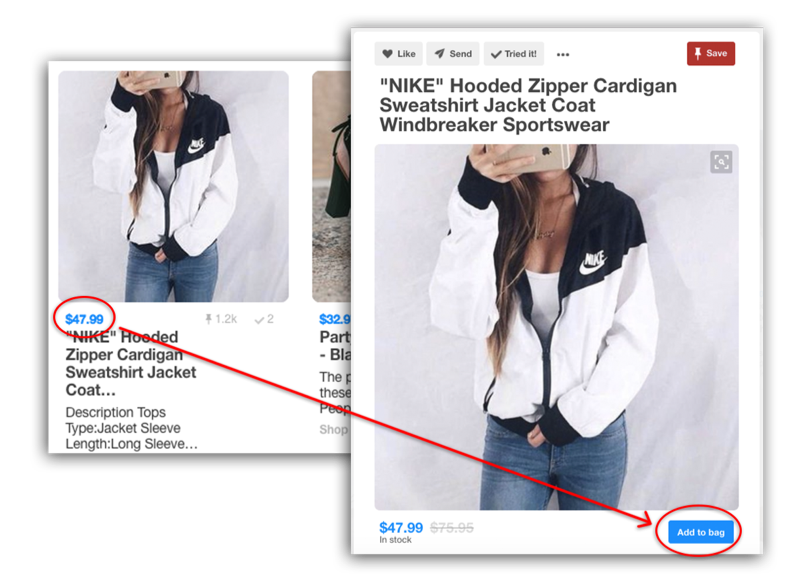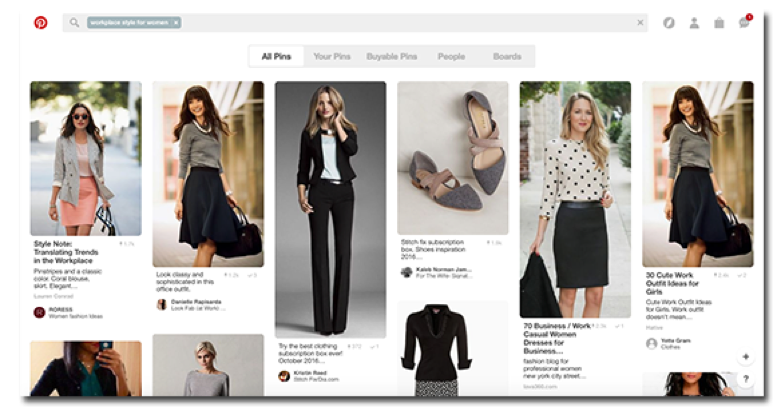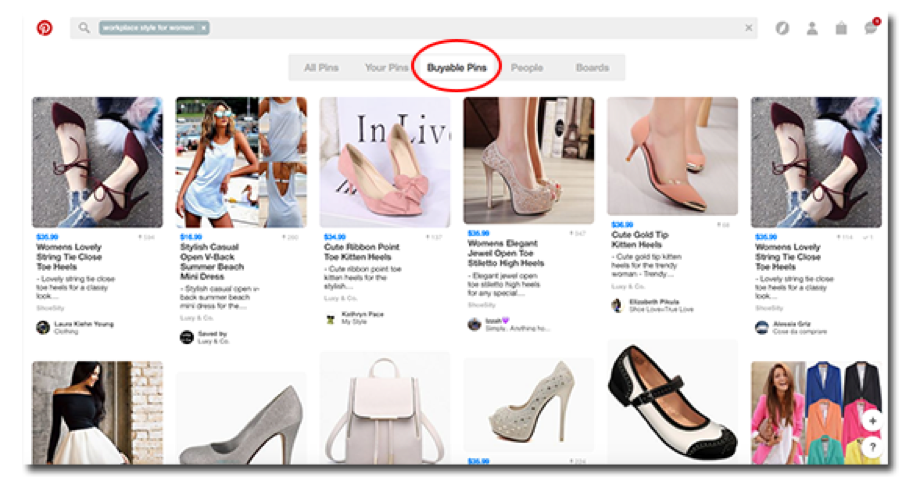In 2016, US eCommerce sales reached nearly $400 billion. This massive boom in online sales further demonstrates a significant shift in the way today’s consumers do their shopping. But with so many competitors, online retailers need to be creative in order to get the biggest share of that profitable pie. Luckily, there’s a relatively new method that can help you do just that: Pinterest Buyable Pins.
What are Pinterest Buyable Pins?
Pinterest has been around since 2010, but Pinterest Buyable Pins came around less than two years ago. So what are they? And how do they differ from regular pins?
Pinterest Buyable Pins are essentially regular pins that can be liked and saved, but with one key difference: consumers can actually buy the item in the pin without even leaving Pinterest.
All you have to do as an ecommerce company is partner with one of the eligible ecommerce platforms and opt to integrate your store items with Pinterest. After that, your pins will have a blue price displayed beneath them that lets users know your item is available for purchase. Plus, it’s worth noting that the price tag and “add to cart” option remain intact when other users repin your item.
The concept may be simple, but it’s incredibly effective. In fact, when it comes to average order size, Pinterest is at number one with an $80 average order. That puts them ahead of major sites like Facebook and Amazon.

Why Do Pinterest Buyable Pins Work So Well?
Part of the reason that Pinterest is such an effective shopping platform is that most of its users are already in a purchase-ready frame of mind. Pinterest has long been considered a giant online scrapbook for wedding planning, designing a dream wardrobe, home decor ideas, and more. But the success of Pinterest Buyable Pins has proved that users aren’t just planning for fun—they’re planning to buy.
So what kind of things are people looking to buy on Pinterest? While there’s a lot to choose from, the most popular categories are retail oriented. According to Millward Brown, some of the top categories include food and ingredients, home decor, clothing, hair and beauty, and health and fitness items.

What Kind of People Use Pinterest to Shop?
It’s also important to look at the kind of buyers using Pinterest Buyable Pins. While it’s true that most Pinners are female, that doesn’t mean you shouldn’t use the platform if your target audience is mostly or all male. Instead, focus on refining the ways in which you reach your target audience. Consider the tags you’re using, the boards you pin on, and other factors. Remember, Pinterest’s male audience doubled in 2014 and their numbers continue to rise.
Another interesting fact that may surprise you is that a large number of shoppers using Pinterest Buyable Pins are entirely new customers—it’s not just existing customers shopping for specific brands they know of. Rather, a huge chunk of these shoppers are discovering and purchasing from new brands just by browsing the site.
So exactly how many are new shoppers? After Buyable Pins was released in 2015, Pinterest reported that 90 percent of its users were newcomers to the brands they purchased from. So if you’re looking to build your customer profile, Pinterest is definitely a great place to start.
Can’t I Just Use Regular Promoted Pins that Point Back to My Own Store?
Well, you could. But there’s a reason Pinterest Buyable Pins are the subject of this post instead of Pinterest Promoted Pins.
When choosing an approach to your Pinterest marketing, or any ecommerce marketing for that matter, it’s important to keep in mind the buyer’s journey.
Pinterest Buyable Pins require the least amount of steps to make a purchase. Users don’t have to go to a new site they don’t recognize or trust, they don’t have to make a new account on your site, and they don’t have to enter credit card information (so long as they’ve made a Pinterest Buyable Pin purchase before). This makes purchases a whole lot easier, which encourages users to buy.
Let’s take a look at a typical buyer’s journey. Say we’re looking for some new, work-appropriate attire. We can find pins directly from our dashboard, or by searching in the Pinterest search bar.
For this example, we’re going to begin our buyer’s journey by searching for “workplace style for women.” (This is another reason why Pinterest is great for online shopping—it allows users to search for very specific terms).

Next, let’s select to filter for “Buyable Pins.”

Then, let’s find an item we like and add it to the cart.

Now that we’ve added the item to our bag, all we have to is go to Pinterest’s integrated shopping cart and checkout with new or previously stored payment and shipping information. And voila! Our new kitten heels will be arriving just in time for that big meeting coming up.
The efficiency and simplicity of this buying method are also fantastic for mobile users—which is a really good thing considering that more than 80% of Pinterest users browse the site from a mobile device.
Is My Merchandise Eligible for Pinterest Buyable Pins?
In order to sell your merchandise using Pinterest Buyable Pins, you’ll need to have a business account with a profile photo that meets Pinterest’s ad standards. You can create a new one or convert your existing account. You’re also required to disclose your business’ contact information and use of any conversion tracking (if applicable).
As far as your actual merchandise is concerned, you cannot create Buyable Pins for any products that fit the following categories:
- Customizable products
- Non-physical goods, like digital downloads
- Live animals
- Any product that falls under our ad standards’ prohibited products and services list. This includes things like:
- Alcohol
- Adult products and services
- Imitation and counterfeit goods
- Products from endangered and threatened species
- Tobacco
- Weapons and explosives
- Weight loss products
So long as your product fits these Pinterest requirements, you can start using Buyable Pins.
Ok, I’m Sold. How Can I Get Started With Pinterest Buyable Pins?
Before you can start using Pinterest Buyable Pins to sell your own merchandise, you’ll first have to partner with one of the eligible ecommerce platforms: BigCommerce, Demandware, or Shopify.
If you’re already connected with one of these ecommerce platforms, then the rest of the process is pretty simple. Use the links above to find detailed instructions for your specific platform.
But aside from the technical aspects of getting set up with Pinterest Buyable Pins, there’s a marketing and planning aspect you need to consider as well.
1. Consider Your Audience
It’s important to consider your target audience and brand essence before creating any type of content—in this case, a Pinterest Buyable Pin. Think of your pin as a product page. Keep in mind that many of the consumers coming across your product will be new customers. Because of this, you want to make sure that it best represents your product while also giving interested new shoppers enough details to feel comfortable with following through on a purchase.
2. Don’t Forget to Analyze the Results
As with any type of marketing, you’ll need to measure and analyze your data in order to make sure that your pins are best optimized. To make matters a bit easier, Pinterest has developed their own integrated analytics tools that allow you to monitor the impressions, views, and engagement of all your Pinterest Buyable Pins. Monitoring this data will help you adjust your pins in a way that allows you to maximize potential reach and sales.
3. Use Promoted Pins and Regular Content Too
In addition to using Pinterest Buyable Pins, you should also invest in Promoted Pins as well. This will give you an extra boost of new interested eyes on your merchandise. Additionally, you’ll want to make sure you’re posting regular content, instead of solely promotions and buyable pins. This is because you need to make sure you’re not just pushing sales on consumers, but providing value to them as well.
Conclusion
Hopefully we’ve convinced you to try Buyable Pins, because it’s an awesome eCommerce tool packed with a lot of potential. However, if you’re not quite ready just yet or if your ecommerce platform isn’t currently supported, then we still encourage you to utilize Pinterest in your marketing efforts. (Remember, Facebook isn’t the only social media site out there). Both paid and unpaid, marketing on Pinterest can bring some astonishing results.








